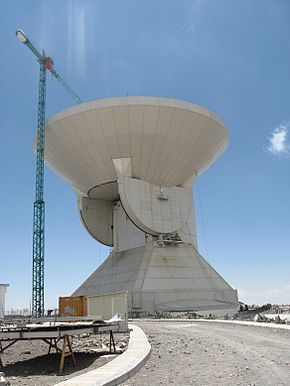Our website is made possible by displaying online advertisements to our visitors.
Please consider supporting us by disabling your ad blocker.
Large Millimeter Telescope
 | |
| Alternative names | LMT |
|---|---|
| Part of | Event Horizon Telescope |
| Location(s) | Sierra Negra |
| Coordinates | 18°59′09″N 97°18′53″W / 18.985833333333°N 97.314722222222°W |
| Organization | National Institute of Astrophysics, Optics and Electronics University of Massachusetts Amherst |
| Altitude | 4,640 m (15,220 ft) |
| Built | 2001–2010 |
| First light | 17 June 2011 |
| Telescope style | Cassegrain reflecting telescope radio telescope |
| Diameter | 50 m (164 ft 1 in) |
| Secondary diameter | 2.5 m (8 ft 2 in) |
| Collecting area | 1,960 m2 (21,100 sq ft) |
| Focal length | 525 m (1,722 ft 5 in) |
| Mounting | altazimuth mount |
| Website | www |
| | |
The Large Millimeter Telescope (LMT) (Spanish: Gran Telescopio Milimétrico, or GTM), officially the Large Millimeter Telescope Alfonso Serrano (Spanish: Gran Telescopio Milimétrico Alfonso Serrano), is the world's largest single-aperture telescope in its frequency range, built for observing radio waves in the wave lengths from approximately 0.85 to 4 mm. It has an active surface with a diameter of 50 metres (160 ft) and 1,960 square metres (21,100 sq ft) of collecting area.[1]

The telescope is located at an altitude of 4,850 metres (15,910 ft) on top of Sierra Negra, the fifth-highest peak in Mexico and an extinct volcanic companion to Mexico's highest mountain Pico de Orizaba, inside the National Park Pico de Orizaba in the state of Puebla. It is a binational Mexican (70%) – American (30%) joint project of the Instituto Nacional de Astrofísica, Óptica y Electrónica (INAOE) and the University of Massachusetts Amherst.
Millimetre-wavelength observations using the LMT give astronomers a view of regions which are obscured by dust in the interstellar medium, thus increasing our knowledge of star formation. The telescope is also particularly fitted for observing solar system planetesimals and planets as well as extra-solar protoplanetary disks which are relatively cold and emit most of their radiation at millimetre wavelengths.[2]
The mission of the LMT is to: 1) pursue pioneering research, 2) train future generations of scientists and engineers, and 3) develop new technology for the benefit of society.[3] The LMT mainly studies thermally cold objects, most of which are associated with large amounts of cosmic dust and/or molecular gas. Among the objects of interest are comets, planets, protoplanetary discs, evolved stars, star-forming regions and galaxies, molecular clouds, active galactic nuclei (AGNs), high-redshift galaxies, clusters of galaxies, and the cosmic microwave background.[4]
The LMT has a bent Cassegrain optical system with a 50m-diameter reflecting primary surface (M1) formed by 180 segments distributed in five concentric rings. The number of segments in the rings, from the center of the dish to the outside, are: 12, 24 and 48 in the three outermost rings. Each segment is connected to the structure of the telescope through four actuators, allowing for an active reflecting primary surface. In addition, each segment is formed by eight precision electro-formed nickel sub-panels. The reflecting secondary surface (M2) has a 2.6-m diameter, also built by nine electro-formed nickel sub-panels, and is attached to the telescope with an active hexapod that allows precise focus, lateral offsets, and tilts. The hexapod is attached to the telescope through a metal tetrapod. Finally, the reflecting tertiary surface (M3) is almost flat, elliptical with a 1.6-m major axis and delivers the light beam to the receivers.[5]
- ^ "General Information". LMT – Large Millimeter Telescope Alfonso Serrano. Retrieved 12 June 2017.
- ^ "Mexico's Large Millimeter Telescope Opens for Business". Science | AAAS. 8 May 2013. Retrieved 12 June 2017.
- ^ "The LMT Book". LMT – Large Millimeter Telescope Alfonso Serrano. Retrieved 12 June 2017.
- ^ "Science with the LMT". LMT – Large Millimeter Telescope Alfonso Serrano. Retrieved 12 June 2017.
- ^ "Telescope Description". LMT – Large Millimeter Telescope Alfonso Serrano. Retrieved 12 June 2017.
Previous Page Next Page
Gran Telescopi Mil·limètric Catalan Large Millimeter Telescope German Gran Telescopio Milimétrico Spanish Grand télescope millimétrique French Large Millimeter Telescope Italian 大型ミリ波望遠鏡 Japanese Large Millimeter Telescope LB Didysis milimetrinis teleskopas LT Wielki Teleskop Milimetrowy Polish Grande Telescópio Milimétrico Portuguese



